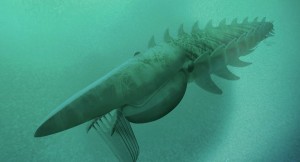Sputnik News
The newly-discovered fossilized remains of a giant arthropod species from the Palaeozoic era have shed light on the subsequent evolution of present-day arthropods such as crabs, scorpions and spiders.
The remains of a giant sea creature from a species which dates back 480 million years, measuring more than two meters in length, have been discovered by paleontologists in southeastern Morocco, making it one of the largest arthropods ever identified, and the largest animal on earth at the time it lived.
Peter Van Roy, co-author of a paper in the journal Nature describing the animal, explained that the researchers decided to name the species Aegirocassis benmoulae. The name Aegir is taken from the ruler of the seas in Norse mythology, and reflects “the fact it would have been unassailable by any other creature,” while cassis means helmet in Latin; additionally it was named benmoulae after its discoverer, Mohamed Ben Moula.
Archaeologists in London Dig Up 3000 Ancient Skeletons
The creature lived during the almost 45 million year Ordovician Period, best known for its diverse marine invertebrates. During this time period, the area north of the tropics was almost entirely covered by ocean. The fossil fragments were discovered in the Early Ordovician Fezouata Biota north of Zagora, which has become one of the world’s most important sources of conserved marine fossils since the first discoveries were made some 12 years ago.
According to the Yale University researchers, studying the fossils sheds light on the early evolution and development of arthropod limbs into the double-branched form characteristic of the legs of modern arthropods, including insects, spiders, centipedes, shrimp, and crayfish.
“Aegirocassis is a truly remarkable looking creature,” Yale University paleontologist Derek Briggs, co-author of the Nature paper, told the press. “We were excited to discover that it shows features that have not been observed in older Cambrian anomalocaridids — not one but two sets of swimming flaps along the trunk, representing a stage in the evolution of the two-branched limb, characteristic of modern arthropods such as shrimps.”
Despite its imposing size, the researchers say that Aegirocassis benmoulae was a filter feeder rather than a predator, in contrast to almost all other anomalocaridids, the group of arthropods to which the new creature belongs. Instead, it had an intricate filter-feeding apparatus with which it sifted plankton while swimming.
“Giant filter-feeding sharks and whales arose at the time of a major plankton radiation, and Aegirocassis represents a much, much older example of this — apparently overarching — trend,” said Van Roy, who explained that the new finding “once and for all resolves the debate on where anomalocaridids belong in the arthropod tree, and clears up one of the most problematic aspects of their anatomy.”
Arthropods make up over three-fourths of all currently known living and fossil organisms, with more than one million documented species, and are the most morphologically diverse animal group on Earth. The true number of their species remains unknown; conservative estimates put the number of arthropod species in tropical forests alone at 6 to 9 million species.
Mystery Solved? Dark Matter Could Have Killed Dinosaurs and Much More










